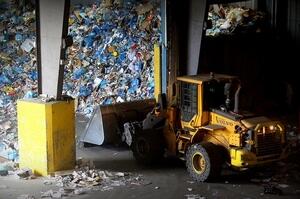“In Europe we generate just over 500 kilos of municipal waste per person each year. If you think that the average weight of a person in Europe is 72 kilos, that means on average we throw away 7 times our own weight. What happens to that waste? Well if you look at the picture across Europe, 37 percent - more than a third - goes to landfills, and only one-quarter is recycled.
But Potočnik is optimistic, explaining that ten years ago more than half of that waste – 56 percent - went to landfill, and less than a fifth - 17 percent - was recycled. Taking a look beneath the European averages statistics show that four Member States - Germany, Austria, Holland and Belgium - are recycling or composting more than 50 percent of their municipal waste, putting those resources back into productive use. While seven Member States are burying more than 80 percent of their waste in holes in the ground; three of them bury more than 90 percent.
“I see this as a tantalising view of what can be achieved; because those best performing Member States were also burying most of their waste a couple of decades ago”, said the Commissioner
What more can we do?
“Energy recovery remains far from the top of the waste hierarchy. That is why we are clear that we must continue to work towards burning only that waste which cannot be re-used or recycled. Incineration can be one element of a waste management strategy, but it is not optimal, particularly in the medium term. Member States seeking to move from the bottom of the waste hierarchy should be careful not to create over-capacity in incineration by investing heavily in such infrastructure without creating the conditions for waste reduction, recycling and composting. We need to take a longer term view, which means that we should design products to last and to be recyclable. In that way we can ensure that fewer of them are incinerated.”
Plastic poses particular challenges
“A particular development over the last decades has been the increasing proportion of plastic waste”, explained Potočnik and added that plastic poses particular challenges. “Perhaps our first step towards “zero waste” should be “zero plastic waste” released to the environment.
As a result of the conference the Commission has published a Green Paper on “a European Strategy on plastic waste in the Environment”. The Paper deals with plastic waste as a single horizontal waste stream and exemplifies how waste, as a resource, must be part of the resource efficiency and resource conservation story. The fundamental issue around which the paper asks 26 specific questions is “how could we do more with less”.
“We are still generating increasing quantities of plastic waste. We have to deal with the waste itself, but also the plastic that escapes from waste streams – better known as litter. Litter is not only unattractive to see; we are now witnessing the consequence of the presence of microplastic in the marine environment. This is a matter of very serious concern”, stressed the Commissioner.
There will be no plastic-free future
The next step the Commission will take is to launch a broad public consultation. “We need to have the views of all stakeholders, including industry, consumers, and public administrations. For Producers, plastic is an attractive material because it is so adaptable and has almost countless applications. It is clear that we cannot count on a plastic-free future, so our aim must be to find intelligent solutions to limit plastic waste as much as possible.”
Challenges for the industry
1. To design plastic and plastic products that can be repaired, re-used or recycled
2. To avoid all toxic material in plastic. Endocrine disruptors and heavy metals should not be found in any plastic.
3. To properly reflect the costs of plastic production in the product price and take responsibility for collection of used plastic goods to ensure recycling or environmentally safe disposal. Producers should also inform consumers about the potential risks stemming from plastic if not properly managed.
4. Industry should make more sustainable use of plastic, and reduce production of items like single-use plastic carrier bags or plastic gadgets that are thrown away immediately after purchase.
What about the consumers responsibility?
According to Potočnik consumers also have a decisive role to play since their demand determines the design and availability of the products. “Consumers increasingly want to make better informed choices when buying, taking into account aspects such as durability and reparability. Do children’s toys systematically have to be made of plastic? Should we as consumers not refuse cheap plastic gadgets just produced for marketing purposes? We also need to promote greater public awareness that plastic is not inert and that it can be a potential danger for the environment when not properly disposed of. We all have to accept our responsibility to collect and take back.”
Responsibilities for public administrations:
1. Ensure a 100 percent collection rate for plastic waste; provide collection points close to citizens and set up technical infrastructure for waste management.
2. Close all channels for illegal landfilling.
3. Help create conditions for recycling to be a profitable business. Diverting all plastics from landfills is already an important element.
4. Systematically apply public procurement to increase the demand for products made from recycling material.
“Waste is often seen as such a big problem. But we have to start to see it as such a big opportunity”, explained Potočnik. Treating waste as a resource would be the real driver leading towards zero waste.
Picture Copyright Sangudo via Flickr

